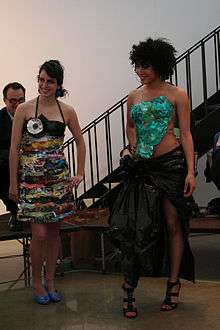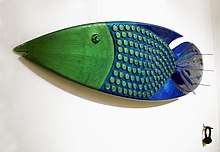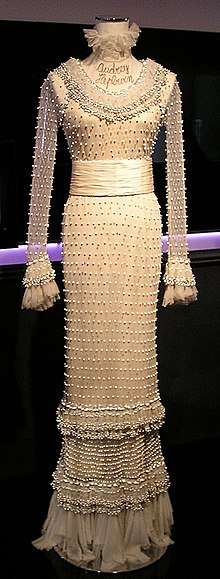Trashion
Trashion (a portmanteau of "trash" and "fashion") is a term for art, jewellery, fashion and objects for the home created from used, thrown-out, found and repurposed elements. The term was first coined in New Zealand in 2004[1] and gained in usage through 2005.[2] Trashion is a subgenre of found object art, which is basically using objects that already have some other defined purpose, and turning it into art. In this case, trash is used.

Initially trashion was used to describe art-couture costume usually linked to contests or fashion shows; however, as recycling and 'green' fashion have become more prevalent, trashion has taken a turn for the more wearable. The term is now widely used in creative circles to describe any wearable item or accessory that is constructed using all or part materials recycled materials, including clothing that has been thrifted and reconditioned.
Philosophy

.
Trashion is a philosophy and an ethic encompassing environmentalism and innovation. Making traditional objects out of recycled materials can be trashion, as can making avant-garde fashion from cast-offs or junk. It springs from a desire to make the best use of limited resources. Trashion is similar to upcycling and refashion, although it began with specific fashion aspirations. Like upcycling, trashion generates items that are valued again, but these items may be either low-cost or high-cost. The environmental aim of trashion is to call attention to and reduce the polluting outcome of fashion waste.[3]
History
Indigenous people throughout the world have used salvaged materials to create new objects for an indeterminate number of years. Africans have made bags from rice and juice packets, Haitians have made sculptural jewelry from old oil cans, and American settlers have made quilts and rugs from cast-off clothing and feed sacks. People were making something from nothing long before the word "trashion" was coined; however, Trashion usually refers to "making something from nothing" for aesthetic purposes, not for practical use.
In the 1990s, American artist Ann Wizer began using plastic waste in her wearable art. Working in the Philippines, and titling her line the 'Virus Project,' Wizer created a set of costumes made entirely from post consumer plastic waste to celebrate Earth Day. The first plastic packaging tote bags were accessories to these costumes. There are now numerous small scale poverty intervention projects throughout Southeast Asia in the process of creating similar trashion accessories and other fashion and homeware items. This includes the XSProject, a charity founded by Wizer and based in Jakarta.
The Trashion movement took off in New York City in late 2004, early 2005 through underground parties on the lower east side of Manhattan at a club called Plan B. Trashion was part of the fashion of Urban Gypsy Circus, which is an interactive art party thrown by multi-media artist Miz Metro. These parties exhibited art made out of recycled materials and included monthly "TRASHION FACEOFFS" where 2 designers would compete to be the "TRASHION QUEEN". This led to Matthew Namer & Miz Metro curating the TRASHION Art show at Gallery 151 on exhibit during the summer of 2009 on the lower east side of Manhattan.
Trashion has become a very popular style of art. For example, in 2006, Julia Genatossio launched Monsoon Vermont, a trashion design house. The company designs items such as umbrellas, shower curtains and backpacks which are made from Jakarta's scavenged trash. Unlike the XSProject, Monsoon Vermont is a for-profit venture.[4]
Trashion is also the subject of school projects,[5][6] local fashion shows,[7] community center exhibits,[8] and fundraisers,[9][10] among other purposes.
Some contemporary trashion artists include Marina DeBris[11][12] and Nancy Judd.[13]
References
- "Turn your trash into 'trashion'," Thread.co.nz, 2004. Retrieved 19 March 2015.
- Scholtus, Petz. "Vaho is Trashion," Treehugger.com, 6 June 2005. Retrieved 19 March 2015.
- "'Trashion' designer Marina DeBris turns ocean rubbish into high-end outfits – in pictures". The Guardian. 13 September 2016. Retrieved 14 September 2016.
- Regis, Necee. "Trash to treasure: artful gear with a conscience," Boston Globe, 7 December 2008. Retrieved 25 July 2009.
- Taylor, Mike (2012-05-18). "'Trashion Show' highlights Activity Night at Greenville Middle School". The Daily News. Retrieved 2013-02-14.
- "It's in the bag for 'Trashion Show' winner". Bates University. Retrieved 2013-02-14.
- Anderson, Charles (2008-07-26). "Teen turns trash to fashion in 'trashion' show". Reporter News. Retrieved 2013-02-14.
- "Trashion features wearable art from recyclables". Sonoma News. 2011-03-18. Archived from the original on 2013-05-10. Retrieved 2013-02-14.
- Sikorski, Colleen (2011-03-27). "Designers present recycled looks at 'Trashion' show Saturday". Indiana Daily Student. Retrieved 2013-02-14.
- "Announcement: Second annual Curb Couture Trashion Show seeking submissions". ABC 24. 2012-07-31. Retrieved 2013-02-14.
- Rebecca Asoulin (August 5, 2011). "Trash Becomes Art". Santa Monica Daily Press. Retrieved 2012-06-26.
- Leonardo, Kathy (June 2012). "The Fashion of TRASHion Lights Up Downtown LA". Whitehot Magazine of Contemporary Art. Retrieved 2013-02-14.
- Stephanie Simon (January 13, 2009). "'Trashion' Trend: Dumpster Couture Gets a Boost at Green Inaugural Ball". Wall Street Journal. Retrieved 2012-06-26.
